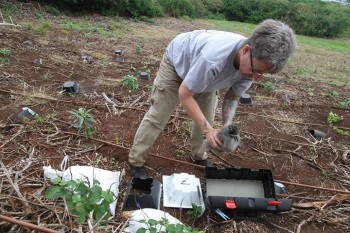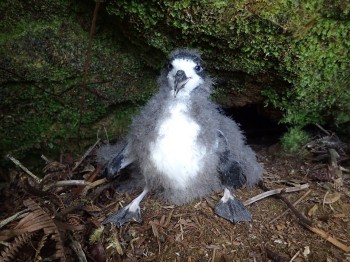So far five of the 10 translocated Vulnerable Hawaiian Petrel Pterodroma sandvicensis chicks have fledged following hand feeding on the USA’s Hawaiian island of Kauai. The chicks had been moved from their mountain breeding sites (where they are at risk to feral cats Felis catus) to an area surrounded by a predator-proof fence within the Kilauea Point National Wildlife Refuge (click here).
Within the secure area artificial burrows had been prepared and a drip irrigation system set up to help establish native vegetation within the Nihoku part of the refuge. The project also involves restoring native habitat in what was once an area full of invasive and non-native plants.

Marilou Knight removes a translocated Hawaiian Petrel chick for feeding in the Nihoku fenced area

A partially downy Hawaiian Petrel chick
Photographs by Andre Raine, Kauai Endangered Seabird Recovery Project
Click here to read how the birds have been cared for and fed by Robby Kohley and Marilou Knight of Pacific Rim Conservation on a slurry of squid and fish until fledging.
The translocation effort is being led on the ground by Pacific Rim Conservation; Kaua‘i Endangered Seabird Recovery Project; Hawai'i Department of Land and Natural Resources; the U.S. Fish and Wildlife Service, Kilauea Point National Wildlife Refuge and the American Bird Conservancy. The National Tropical Botanical Garden provided important assistance with vegetation restoration at the translocation site. The National Fish and Wildlife Foundation provided funding support.
John Cooper, ACAP Information Officer, 26 November 2015

 English
English  Français
Français  Español
Español